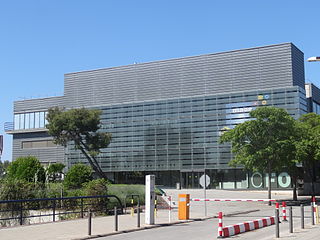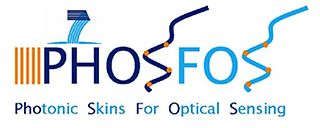Related Research Articles

Optoelectronics is the study and application of electronic devices and systems that find, detect and control light, usually considered a sub-field of photonics. In this context, light often includes invisible forms of radiation such as gamma rays, X-rays, ultraviolet and infrared, in addition to visible light. Optoelectronic devices are electrical-to-optical or optical-to-electrical transducers, or instruments that use such devices in their operation.

Photonics is a branch of optics that involves the application of generation, detection, and manipulation of light in form of photons through emission, transmission, modulation, signal processing, switching, amplification, and sensing. Photonics is closely related to quantum electronics, where quantum electronics deals with the theoretical part of it while photonics deal with its engineering applications. Though covering all light's technical applications over the whole spectrum, most photonic applications are in the range of visible and near-infrared light. The term photonics developed as an outgrowth of the first practical semiconductor light emitters invented in the early 1960s and optical fibers developed in the 1970s.
SPIE is an international not-for-profit professional society for optics and photonics technology, founded in 1955. It organizes technical conferences, trade exhibitions, and continuing education programs for researchers and developers in the light-based fields of physics, including: optics, photonics, and imaging engineering. The society publishes peer-reviewed scientific journals, conference proceedings, monographs, tutorial texts, field guides, and reference volumes in print and online. SPIE is especially well-known for Photonics West, one of the laser and photonics industry's largest combined conferences and tradeshows which is held annually in San Francisco. SPIE also participates as partners in leading educational initiatives, and in 2020, for example, provided more than $5.8 million in support of optics education and outreach programs around the world.
Sir David Neil Payne CBE FRS FREng is a British professor of photonics who is director of the Optoelectronics Research Centre at the University of Southampton. He has made several contributions in areas of optical fibre communications over the last fifty years and his work has affected telecommunications and laser technology. Payne’s work spans diverse areas of photonics, from telecommunications and optical sensors to nanophotonics and optical materials, including the introduction of the first optical fibre drawing tower in a university.

ICFO – The Institute of Photonic Sciences is a research center devoted to the science and technology of light. Located in Castelldefels, ICFO was created in 2002 by the Government of Catalonia and the Technical University of Catalonia.
Federico Capasso is an applied physicist and is one of the inventors of the quantum cascade laser during his work at Bell Laboratories. He is currently on the faculty of Harvard University.
The Fraunhofer Institute for Applied Optics and Precision Engineering (IOF), also referred to as the Fraunhofer IOF, is an institute of the Fraunhofer Society for the Advancement of Applied Research (FHG). The institute is based in Jena. Its activities are attributed to applied research and development in the branch of natural sciences in the field of optics and precision engineering. The institute was founded in 1992.
A photonic integrated circuit (PIC) or integrated optical circuit is a microchip containing two or more photonic components which form a functioning circuit. This technology detects, generates, transports, and processes light. Photonic integrated circuits utilize photons as opposed to electrons that are utilized by electronic integrated circuits. The major difference between the two is that a photonic integrated circuit provides functions for information signals imposed on optical wavelengths typically in the visible spectrum or near infrared (850–1650 nm).

Photonics Spectra is a monthly business-to-business (B2B) magazine published for the engineers, scientists, and end users who develop, commercialize and buy photonic products. It provides both technical and applications information for all aspects of the global industry, integrating all segments of photonics: optics, lasers, imaging, fiber optics and electro-optics as well as photonic component manufacturing, solar cell improvements, LED lighting for cars and offices, THz, EHz, UV, IR, and visible light imaging and test equipment.
Ophir Optronics Solutions is a multinational company that sells optronics solutions. The company develops, manufactures and markets infrared (IR) optics and laser measurement equipment. Founded in 1976, the company was traded on the Tel Aviv Stock Exchange from 1991 until it was acquired, and was a constituent of its Tel-tech index. Headquartered in the Har Hotzvim industrial park in Jerusalem, Israel Ophir owns a 100,000-square-foot (9,300 m2) complex that includes the group's main production plant. Ophir has additional production plants in North Andover, Massachusetts and Logan, Utah in the US and sales offices in the US, Japan and Europe. In 2006, Ophir acquired Spiricon Group, a US-based company in the beam-profiling market. Ophir's sales increased sharply from $45 million in 2005 to $74 million in 2007. During 2007, Ophir established a Swiss-based subsidiary to market lenses and components for surveillance and imaging systems in Europe. In May 2010, Ophir acquired Photon Inc., another US-based beam-profiling company. Newport Corporation, a global supplier in photonics solutions, completed its acquisition of the Ophir company in October 2011. In 2016, metrology firm MKS Instruments bought Newport Corporation, including the Ophir brand, for $980 million.

The University of Arizona College of Optical Sciences, considered the largest institute for optics education in the United States, is dedicated to research and education in optics with an emphasis on optical engineering. The college offers more than 90 courses in optical sciences, and a Bachelor of Science degree in Optical Sciences and Engineering, Masters and Doctoral degree programs in Optical Sciences, as well as a dual master's degree in Optical Sciences and Business Administration. The college also offers comprehensive distance learning courses leading to a Professional Graduate Certificate or a master's degree and markets non-credit short courses on DVD to optics professionals.
The IEEE Photonics Society, formerly the IEEE Lasers and Electro-Optics Society (LEOS), is a society of the Institute of Electrical and Electronics Engineers (IEEE), focused on the scientific and engineering knowledge about the field of quantum electronics. In the hierarchy of IEEE, the Photonics Society is one of the close to 40 technical societies organized under the IEEE Technical Activities Board.
Photonics Society of Poland is the largest optics/optoelectronics/photonics organization in Poland. It was transformed from the SPIE Poland Chapter on October 18, 2007 during the Extraordinary General Meeting of the SPIE Poland Chapter members.
D-Lightsys, a Radiall Company, designs and manufactures high performance optical interconnect products for severe environment applications. D-Lightsys products are based on optoelectronic components. The company headquarters are located in Aubervilliers, near Paris, France. Products are manufactured in Isle d’Abeau, near Lyon, and are sold through the Radiall sales network under the D-Lightsys brand.

PhoSFOS is a research and technology development project co-funded by the European Commission.

Anurag Sharma is an Indian physicist and a professor at the department of physics of the Indian Institute of Technology Delhi. He is known for his pioneering researches on optoelectronics and optical communications and is an elected fellow of all the three major Indian science academies viz. Indian Academy of Sciences, Indian National Science Academy and National Academy of Sciences, India as well as Indian National Academy of Engineering. The Council of Scientific and Industrial Research, the apex agency of the Government of India for scientific research, awarded him the Shanti Swarup Bhatnagar Prize for Science and Technology, one of the highest Indian science awards for his contributions to Engineering Sciences in 1998.
John Michael Dallesasse is a Professor of Electrical and Computer Engineering at the University of Illinois at Urbana–Champaign where his research is focused on silicon photonic integrated circuits (PICs), nanophotonics, semiconductor lasers / transistor lasers and photonics-electronics integration. He has over 60 publications and presentations, and holds 29 issued patents.

Anatoly V. Zayats is a British experimental physicist of Ukrainian origin known for his work in nanophotonics, plasmonics, metamaterials and applied nanotechnology. He is currently a Chair in Experimental Physics and the head of the Photonics & Nanotechnology Group at King's College London. He is a co-director of the London Centre for Nanotechnology and the London Institute for Advanced Light Technologies
Manijeh Razeghi is an Iranian-American scientist in the fields of semiconductors and optoelectronic devices. She is a pioneer in modern epitaxial techniques for semiconductors such as low pressure metalorganic chemical vapor deposition (MOCVD), vapor phase epitaxy (VPE), molecular beam epitaxy (MBE), GasMBE, and MOMBE. These techniques have enabled the development of semiconductor devices and quantum structures with higher composition consistency and reliability, leading to major advancement in InP and GaAs based quantum photonics and electronic devices, which were at the core of the late 20th century optical fiber telecommunications and early information technology.
John Ballato is an American materials scientist, entrepreneur, and academic. He holds the J. E. Sirrine Endowed Chair of Optical Fiber and is a professor of materials science and engineering, electrical and computer engineering, as well as physics and astronomy at Clemson University. He has received many international recognitions for his research on optical and optoelectronic materials, particularly as relates to optical fiber.
References
- ↑ The European Photonics Industry Consortium
- ↑ "The International Optoelectronics Association Membership". Archived from the original on 2008-07-04. Retrieved 2009-01-04.
- ↑ Five European Companies found EPIC Compound Semiconductor 5 January 2004,
- ↑ Industry Associations Create Stability during Downturns. Optics and Laser Europe, p.38, April 2009 [ permanent dead link ]
- ↑ European Workshop on Optics and Photonics Technologies
- ↑ Launch of Photonics-21
- ↑ European MONA project publishes roadmap for photonics and nanotechnologies Small Times, 4 February 2008
- ↑ "The MONA Roadmap for Photonics and Nanotechnologies". Archived from the original on 2009-02-11. Retrieved 2009-01-04.
- ↑ "The ACCORD Program for access to prototype photonic components and systems". Archived from the original on 2009-04-30. Retrieved 2019-12-12.
- ↑ "LIFT Project Web Site". Archived from the original on 2019-05-15. Retrieved 2019-12-12.
- ↑ Fiber Laser FaserLaser